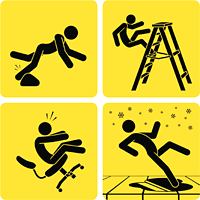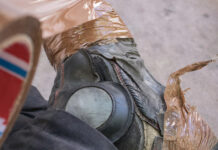Here are our top 10 hazards that occur in workplaces all too often. Although there are many more dangers on job sites, we feel that this list deserves some attention. Educate yourself on what can cause potential hazards and read up on how you can safely prevent them from ruining your day.
1. Slips, trips, and falls
Falls from tripping over who-knows-what (uneven floor surfaces, wet floors, loose cables, etc.) are easily the most common cause of injuries at work. Employers have to fork over big bucks to cover the cost of all of these mishaps, and sadly, most of them could be prevented if safety regulations were followed properly. It’s the responsibility of employers and workplaces to make sure employees are working in a safe environment.
Accidents will happen, but there are simple steps that can be taken to ensure employees’ safety, such as cleaning up spills, putting equipment (especially if there are trailing cables) back where it belongs, improving lighting, and requiring workers to wear slip-resistant footwear.
2. Electrical
Any “live” wires can harm people, whether they touch it directly, or indirectly through some sort of conducting object or material. Voltages over 50 volts AC (120 volts DC) are considered hazardous and should be taken seriously. Unfortunately, some electrical accidents that happen at work each year are fatal. Shocks can cause severe, permanent injuries. These are caused by faulty equipment that can be checked as a preventative measure.
Some basic electrical safety steps include: maintaining all electrical installations, choosing the right equipment for the job (workers can wear electrical hazard rated footwear), and replacing any damaged sections of cables. Faulty electrical appliances can sometimes lead to fire, too.
3. Fire
Businesses that have poor housekeeping standards, public access (for possible arson), and poorly maintained equipment can be harmed more by fires. Along with buildings, people and stock can be affected, and once again, safety precautions can be taken as an attempt to avoid such a dangerous thing from happening. We all probably learned about fire safety in elementary school, so having fire alarms and detectors throughout the building should be no-brainers. Testing these frequently is a way to keep a building safe, as well as making sure they’ll still function on a different back-up power supply, even if the power is out. Employees need to be aware of how the alarm system works, and a proper escape plans need to be established and made known to all workers.
Fire extinguishers throughout the building (and maintenance of all fire-fighting equipment) serve as part of a common workplace plan of action in case of an emergency. If employees work around flames, fire-resistant workwear should be required. Highly flammable materials should be handled properly, electrical equipment not in use needs to be switched off, and even something as simple as totally putting out a cigarette butt are precautionary measures. Employers and employees alike play a role in preventing fires from occurring in the workplace.
4. Working in confined spaces
Places that are mostly enclosed can become dangerous locations to work. Chambers, tanks, silos, vats, pits, trenches, sewers, drains, ductwork, and unventilated or poorly ventilated rooms can increase the risk of death or serious injury. Welding, painting, flame-cutting, and the use of chemicals in small areas can create dangerous work conditions. Poor training can injure not only workers confined in these spaces, but also those attempting to rescue them. Here’s yet another list for you, involving some of the dangers that can occur if you’re not careful: lack of oxygen; poisonous gas, fume, or vapor; liquids and solids suddenly filling the confined space or releasing gases into it when they’re disturbed; fire and explosions; residues left behind can give off gas, fume, or vapor; dust; and hot working conditions.
One fairly obvious way to reduce your risk from working in confined spaces is to AVOID ENTRY INTO CONFINED SPACES. Is it really necessary to go into said place and work there? If it’s absolutely unavoidable, follow safety precautions. Include proper training and instructions in order to safely complete any necessary work and make emergency arrangements before you even start working.
5. Physical hazards
This is somewhat of a generic work hazard to mention, but it’s an important one. Physical hazards are some of the most common hazards, and they show up in the workplace too often. Frayed electrical cords, unguarded machinery, exposed moving parts, vibrations, and working from ladders, scaffolding, or heights.
As you wander about during your work day, you’ll probably come across one or more of these problem areas. Doing what you’re supposed to be doing (aka working hard and not doing dumb stunts) will help maintain a safe work environment. Employers are to ensure employees safety, and that includes educating workers on how to properly operate, work around, and take care of work equipment.
6. Ergonomical hazards
When the type of work you do plus your body position and/or working conditions all put a strain on your body, that can become an ergonomical hazard. Since they don’t always immediately affect you, this can be tricky to identify. Repetitive, awkward movements could be affecting your back, posture, and more. Ergonomics is used to reduce the wear and tear on your body that can eventually make a task difficult – or even painful. To improve efficiency, increase job satisfaction, and reduce the risk of fatigue, short-term pain, or illnesses, it’s important to incorporate ergonomic principles within the workplace. Instead of doing the same thing over and over, task variety will minimize repetitive movements. Having an appropriate work pace gives the body time to recover after certain movements, like lifting. Work breaks also give the body time to recover, and they provide workers with a mental break, too.
Training can help employees learn exactly how to complete tasks in the best possible way to avoid strains and injuries. Organization is yet another helpful idea to make the workplace more efficient – having tools, materials, and equipment in easy reach doesn’t make employees lazy…these strategies will improve production and make employees comfortable with their work environment.
7. Chemical hazards
These are what can make confined spaces so hazardous. When you’re exposed to any chemical preparation (whether it’s a solid, liquid, or gas), these can be potential chemical hazards. Cleaning products and solvents, vapors and fumes, carbon monoxide, gasoline, and flammable materials are all things that can damage your health. Skin irritations, burns, eye injuries, and blindness can occur if you’re not careful. Solvents can easily catch on fire, and spray paint cans are capable of exploding. Hazardous substances will be labeled and include symbols with different class levels, so you’ll know when to be cautious. Always read these labels and follow the directions and precautions precisely. If you don’t know how to correctly use a product, don’t use it.
Protect yourself and those around you by disposing of chemicals properly. Reducing the use of hazardous chemicals is a way keep the workplace safe. Providing adequate ventilation, washing your hands, minimizing exposure to chemicals, maintaining equipment to prevent leaks and breakdowns, and using personal protective gear, like Black Stallion chemical-resistant gloves, all minimize the effects of dangerous chemicals.
8. Biological hazards
Blood or other bodily fluids, bacteria and viruses, insect bites, and animal and bird droppings are all considered biological hazards. These are also called biological agents, and they can cause illnesses and diseases in humans. Parasitic worms and some plants are biological agents. Through physical contact, you can contract these illnesses, so it’s important to practice good personal hygiene. Some infectious agents are transmitted directly (through physical contact, droplets from a sneeze or cough, or by an injection or puncture), while others are passed indirectly (by attaching themselves to food, water, or eating utensils, when an insect carries them from an infected person to a non-infected person, or when inhaled through the air).
Can you tell we’re trying to keep you on-edge here? Since you can contract viral infections, such as mumps and measles, keep your immunizations up-to-date. Clean and disinfect – a lot. If you handle bio-hazardous waste materials, please do so safely. Even if you think you’re in the clear, blood and any other bodily fluids should always be handled as if they could be infectious. Wearing personal protective equipment, like gloves and masks (Sundstrom safety kits are available at Working Person’s Store) can prevent infections from occurring as well.
9. Asbestos
Asbestos deserves its own ranking – it can lead to the development of breathing difficulties and mesothelioma (a type of cancer) after exposure, so we thought it was important to mention. Asbestos fibers can pass through your lungs and stay there for many years. There’s no way to remove the fibers once they’ve reached your lungs, and so far, there’s no cure for the diseases they cause. There are three types of asbestos: brown (amosite), blue (crocidolite), and white (chrysotile). These are all potentially dangerous. The fibers are durable and resistant to heat and flame. They’re thin and flexible, too, and have been used in consumer, industrial, automotive, and other building projects, mainly those that were built before the year 2000.
Workers that have to perform maintenance on buildings with asbestos are most at risk. Insulation, fire protection, and paints are some of places it can be found on buildings. To reduce your risk of asbestos-related sicknesses, decide how to prevent any disturbances of asbestos on the premises. If there’s asbestos present, decide whether it should be removed or left in place – its condition will determine this. Special asbestos contractors can help you decide what steep to take next.
10. Noise
Say what? So maybe your parents were right when they told you to “Turn down your music – it’ll damage your eardrums!” Loud noises in the workplace can cause permanent damage to your hearing, whether you want to believe it or not. Hearing loss can happen progressively, or it can be caused immediately by exposure to peak sound waves produced by explosive sounds, such as gunfire, explosions, or cartridge operated tools. If you work in a noisy place, like a factory or construction site, or even at an airport, you are among those most at risk. Just because you’re used to it doesn’t mean it’s not affecting your hearing.
If people have to raise their voices to be heard from even just a yard away, that’s a good indication that the noise level is reaching a harmful level. Employers need to provide instruction to workers on how to minimize their risk, like how to use hearing protection. Equipment maintenance is important, as always, and employers should work to reduce the sources of noise if possible. Enclosing noisy machinery away from workers can help, and limiting access by keeping people out of noisy areas altogether can make a big difference in controlling exposure.
So, regardless of what your job, please be safe out there! Working Person’s Store has nearly all the work and footwear you need to aid in your protection from workplace hazards.




